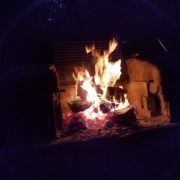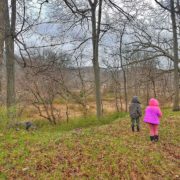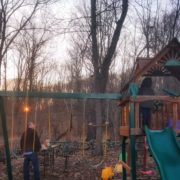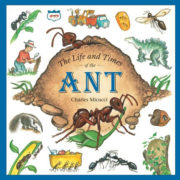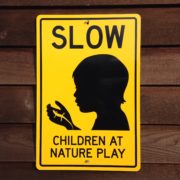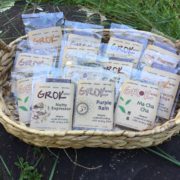
Photograph Courtesy of family+footprints.
Talking about forest play is perfectly fine when you actually have a "forest" nearby, but for many of us, finding an untouched, preserved area of natural land close to home can be challenging. What surrounds us can often be at odds with our vision of forest exploration.
Take the suburbs. Live there and chances are you encounter landscaped parks or tracts of land, along with roads and developments more than open fields and deep woods. If this is where you call home, but you're still hoping for a more outdoorsy, wild experience for the little ones you love, fear not. To quote my great-grandmother, "Nature is all around you, you only need to look for it." It may not look like everywhere else, but it's out there and we interact with it constantly. And in practice, a small stretch of trees or wetlands holds a world of opportunity to explore, especially in the eyes of a child, where the world is already so large.
So fellow suburbanites, let's figure out how to find wilderness near you.

Photograph Courtesy of family+footprints.
01. Remember your own childhood
To recall just how big a smaller patch of woods seems to a child, go back in time to your own childhood. What outdoor experiences did you have? Do you remember feeling as though a spot you found was massive as a child only to return as an adult and realize just how small it was? As child of the suburbs myself, mine was a wildly overgrown, narrow stretch of land buffering our neighborhood and a highway. My friends and I loved roaming back there. It felt like our own corner of the world. As an adult, it's hard to believe that space ever felt sacred. Cars on one side of a barrier, houses on another. But it was ours and it felt otherworldly. So if you're feeling worried that your space isn't wild enough, watch your child or listen to them talk about their experiences. Chances are our idea of wilderness and theirs may be quite different.
02. Check a map
That being said, if you can find more expansive pockets of wilderness near you - and there's a good chance you can - head there. The experiences certainly become enriched the more natural the setting. If you're not sure where to start, check out a Google Map view of your town. Look for pockets of green, follow rivers and seek out reservations, national parks, swamps and preserves that might be nearby. Zoom out if you need to in order to expand your search parameters. One of our favorite nature walks in less than 1000 ft across, but follows along a river where no development can really take place. Small patches, big impact. And even in the suburbs of Northern New Jersey, we have two reservations within a half hour drive that cover almost 4,000 acres. Nature is out there, most definitely.

Photograph Courtesy of family+footprints.
03. Avoid playgrounds
But as you look at the map, the patches of green may very well be parks with playgrounds on them. Playgrounds - especially unstructured playgrounds - can be a beautiful part of your child's play and of their very childhoods. The essence of exploring nature, though, is unique in and of itself. In that case nature is your child's playground. You may find that if your location has a playground it can distract from the experience with which you'd like to connect. So try to find places that emphasize nature more than anything else. That is where your children's creativity and collaboration and all the other benefits that come out of forest play really start to come alive.
04. Seek out varied terrain
It's truly lovely when you have an untouched stretch of land within walking or biking distance from home. Most often, that is not the case in the suburbs. Whether or not that's a reality though, you may want to incorporate a location that requires a drive. If that drive provides you access to a larger wooded or wetland area, the benefits will expand, even with spending some time in the car. So consider areas outside of your town or surrounding towns. Where can you get to in under and hour? Where are other local groups already formed? Can you find trees or water or hills, sand or rocks or marshland? Each terrain brings on it's own adventures. Explore the different kind of experiences you get when you expand your geographical scope.

Photograph Courtesy of family+footprints.
05. Scout it out + test it out
Once you have some leads - and they will come! - scout them out. Watch out for aspects that seem hazardous to you, as well positives aspects, such as elements that provide enough of an interactive space for your children. Consider access for you and your friends. Each of those considerations and logistics may make life easier down the line. If it feels like a solid lead, test it out with your kids. Don't be afraid to change spots based on weather, season, new hazards or any other variables. At the same time, don't be afraid to keep a location if your kids are really connecting with it. There will be plenty of time for field trips to check out new settings, but allow the connection to form. A child opens up and deepens their exploration in new ways as they become more and more comfortable with a place of the right fit.
Have other suburban success stories? Tell us about them. We'd love to hear more!



